
Wound Dressings Page Menu: 1 2 3 4 5 6 7 8 9 10 11 Next>>
Wound Dressings in the Golden Age of Piracy, Page 6
Bolsters/Compresses
The word 'bolster' is an unusual one that would seem to have fallen out of date. Perhaps it was never in popular use given that Pierre Dionis reassures as that "You will be perfectly acquainted with the Nature of Bolsters, when I shall have inform’d you of what, how, and wherefore they are made."1Many of the period authors talk about bolsters in a manner that hints they are different than bandages2, although they are often lumped together with them.
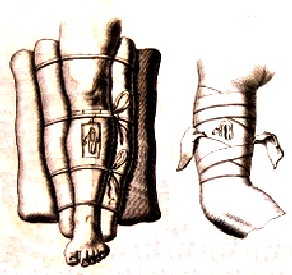
Complex Wound Dressings Featuring Bolsters,
From Alle de Medinale en Chirurgicale, by Solingen
Cornelius, Table 13 (1696)
Pierre Dionis explains that bolsters were "pieces of Linen Cloth folded several times double, with which we cover or surround a part; they are used either dry or moisten’d in some Liquid, pursuant to the respective intention of their use. They are called in French Compresses, which Name they derive from their Compression of the part to which they are apply’d, and that it may be equally pressed all over as it ought to be"3. While 'compress' is more familiar to us today, period authors more commonly refer to these pads as bolsters.
Dionis explains that bolsters "serve for five Ends. First of all, they secure and fasten the Bandage. Secondly, They conserve the Heat of the Part which they defend from Cold. Thirdly, They keep on the Sore the Liquors [liquids - probably medicines in this case] which they have imbib’d. Fourthly, They fill up the inequalities of an Arm, or a Leg [the missing skin in the wound], and make the Band fit the better. Fifthly, they prevent the Laqei [this is not entirely clear, but he may mean the entangling of the bandage] in its extension of the Part, by reason it is then wrap’d around with a Circular Bolster."4
1Pierre Dionis, A course of chirurgical operations: demonstrated in the royal garden at Paris. 2nd ed., p. 29; 2 See for example Ambroise Paré, The Workes of That Famous Chirurgeon Ambroise Parey, p. 359, John Moyle, The Sea Chirurgeon, p. 49, Matthias Gottfried Purmann, Chirurgia Curiosa, p. 14 & John Atkins, The Navy Surgeon, p. 205; 3 Dionis, p. 28; 4 Dionis, p. 29
Bolsters/Compresses: Composition
Dionis explains that bolsters are "always [made of] Linen Cloth, which ought to be even, soft, clean and well wash'd in Lye or Sope-Suds. They must be very thick when a great Pressure is requisite, or the Part is to be defended against a severe Cold. New Linen is improper; and 'tis a general Rule, that all the Linen which a Chirurgeon uses ought to be always half worn, that it may be the more pliable and soft."1 He warns that, like bandages, they "must be wholly free from all manner of Seams"2.
1,2 Pierre Dionis, A course of chirurgical operations: demonstrated in the royal garden at Paris. 2nd ed., p. 29
Bolsters/Compresses: Their Form
Since Dionis gives us most of the information about bolsters, we once again turn to him for a description of the different types of them. If you compare the forms of bolsters and plasters, you will immediately notice a similarity in form. This is because bolsters were often used to cover plasters.
The first, A, of all the Bolsters is the quadrangular, and that most frequently used,
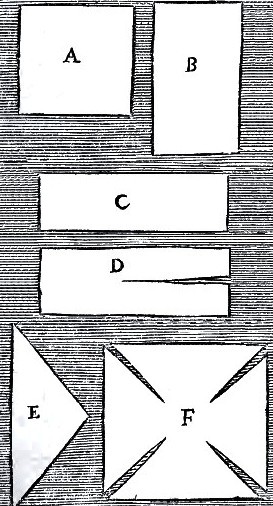
"Des Compresses" Table 6 from Cours d
Operations
by Pierre Dionis p. 45 (1740)
because proper in many Cases, and fit to be applied to all places of the Body. 'Tis made large or small, as occasion requires.
The second, B, is by the Ancients [Ancient surgical writers] called the Splenic Bolster, from its shape which is oblong resembling that of the Spleen. It also admits of different Names, pursuant to its various manners of Application; being put on upwards 'tis call'd a long Bolster, when apply'd a-cross 'tis term'd transversal, and when obliquely an oblique Bolster.
The third, C, is the long Bolster, so call'd when apply'd the length on a Leg or Arm; tho' if wrap'd around those Parts, 'twould be term'd circular: 'Tis much narrower than long, and is not commonly fixed according to the length of the Part any otherwise than under a Splent; when 'tis used circularly 'tis to tender a Member even, or hinder the Laqui [unclear, but probably tangling up] with which 'tis bound from Paining it.
The fourth, D, is a circular Bolster cut at one end to the middle, which renders it the faster to be apply'd to the uneven Places of a Part, and to Fractures of the Arms and Legs, in which Cases the Chirurgeon cannot be without it.
The fifth, E, from its Figure styl'd triangular, is proper for the Groin, and is always made very thick, that by a vigorous Pressure it may prevent the falling of the Epiploon or Intestines thro' the dilated Rings of the Muscles of the Abdomen.
The sixth, F, shaped like a Maltese Cross, to adapt it the more exactly to the extremity of the amputated part, for 'tis particularly used in Amputation; it ought to be whip'd at each Angle, lest the several pieces of Linen which thicken it being loose, should wrinkle as 'tis laying on.
The seventh, G, is a Window Bolster with an Aperture in the middle, to admit the egress and regress of the Air by the Windpipe, after the Operation called Bronchotomy; 'tis also of great use in Fractures with Wounds.
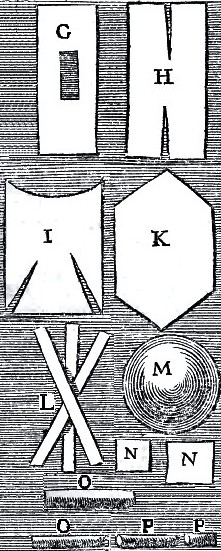
"Des Compresses" Table 6 from Cours
d Operations
by Pierre Dionis p. 45 (1740)
The eighth, H, is the trapezial Bolster, shaped like the Plaister of that Name, that is, cut in at each end in order to fit it the better to the Members of an unequal Surface, on which 'tis always laid circularly.
The ninth, I, is a large square Bolster, cut from its two inferior Angles towards the middle, to accommodate it to the shape of a Shoulder, which is to be cured in case of Luxations of the Humerus, i.e. Shoulder, and the Omoplata, or Shoulder Bone.
The tenth, K, is call'd the Lozenge Bolster, because its sides or edges, which are six, make oblique Angles which are equal to their opposite Angles, as are also the sides; this Shape is frequently given to Bolster rather than round, because they serve to the same purposes as the circular, and 'tis easier and more expeditious to cut in a right Line the four Angles of a square Bolster, which is the most common, than to shape a round one exactly.
The eleventh, L, is composed of three narrow long Bolsters, two of which intersect each other like St. Andrews Cross, and the other, which you see vertically situate, cuts the other at acute Angles, they are successfully apply'd in this order in Ancurisinæ and Varices [veins]; because that having three Bolsters in the middle, they they more compress the Place where the Vessel is open or relaxed.
The twelfth, M, is a round Bolster, of which sort there are some as perfectly round as Balls; and others which are only so on one side like half Globes; Both the one and the other are put under the Arm-pits, before making the Bandage, after the Reduction of a luxated Shoulder; one of them is also clap'd into the Hands of those who have dislocated or broken their Arm Bones.
To conclude, these last are little Bolsters, some of which, N, N, are thick and square, to be apply'd after Bleeding in the Arm or Foot. The two O, O, are long; they are used with Ligatures of the Vessels to tie the Thread upon; and the two others, P, P, are rolled and very small, in order to be employ'd in Sutures, and particularly those of a Tendon."1
1 Pierre Dionis, A course of chirurgical operations: demonstrated in the royal garden at Paris. 2nd ed., p. 29-30
Bolsters in Surgery
Like every other type of dressing we've looked at, bolsters were used in several different surgeries and dressings of various wounds. While they appear repeatedly in fractures and luxations, let's look at another interesting surgery here.
Bolsters in Surgery: Head Wounds
As mentioned in the previous chapter, trepanning involves making a hole in the skull to relieve pressure on the brain. When bolsters or compresses are mentioned in this operation, they are usually recommended during the second dressing - the dressing after the operation has taken place.
Military surgeon Richard Wiseman uses them on the second dressing following trepanation of a ten year-old boy who was "struck down by a blow of a Cudgel on his Head"1. He explains that he "drest up the Bone with
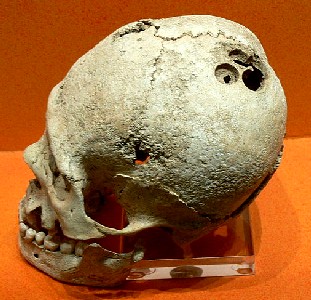
Photo: Wolfgang Sauber
Trepanned skull from the Museo del Sitio in Monte Albán
liniment. Arcei warm, so as to give way to the Lips [of the wound] to fall in; I desiring no more Opening than was necessary for discharge of the Matter from within. Over these Dressings, I applied empl. diachalcith. malaxed cum ol. ros & aceto [a plaster of oil, litharge and copper salts kneaded with rose and olive oils], and with Compress and Bandage concluded the second Dressing."2 Here Wiseman has outlined a typical wound dressing involving a plaster - 1. The Plaster, 2. A bolster/compress of the same type, but slightly larger and 3. Bandages to hold the dressing.
Sea surgeon John Moyle used compresses in dressing fractures of the skull. One case involved the treatment of a skull fracture to a "Mariner, aged about 34 Years, [which] happened by Violent Stroke with an Iron Crow (in Boarding of the Enemy)"3. During the third dressing, Moyle desired a "perfect Digestion [formation of pus in the wound], [so] I dressed it the third time, after the same manner; only I added a Compress on the digestive Dossels and Cataplasm... and made the Bandage over as before."4
While that case didn't actually require trepanning, another, similar case did. Moyle was treating a "Young Sailor [who] running hastily in at the Steerage door, and hitting his Head violently against a cross Beam, was struck down backward, and receiv’d a severe Bruise on the Sinciput [front of the skull], near the Coronal Suture
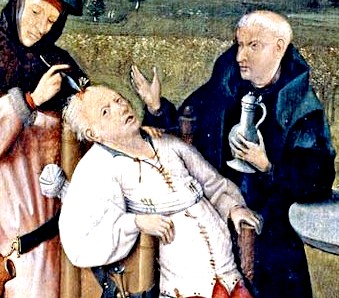
Scalp Incision from The Stone Cutting by Hieronymus Bosch
(13th - 14th century)
"5. Moyle dressed it as before, but "two or three days after the Man complain'd of an exceeding great Pain in his Head: this Pain increasing so, that he had no rest Day nor Night."6
Moyle "prevailed with the Man to let me make incision [in his scalp], and see [if he could detect damage to the skull]; to which the Man consented. So I made decussate Incision [an incision in the form of an 'X'], and turned up the Angles, and razed off the Pericrane [cut the Periosteum - the membrane lining the outer surface the skull], and gave it a restringent [tissue drawing] Dressing at this time of Pulv. Galeni [made from berberis berries], &c. and put it on a Compress, expressed out of acet. Vini [vinegar], and bound it up."7 This failed to solve the problem, so Moyle resorted to trepanning which appeared to work.
Sea surgeon John Atkins reports another head wound case that involved "a Lad that had fell from the Main-Yard of a Ship, and who was supposed to have fractured the Skull, he having vomited, bled at the Nose and Ears, and besides lay speechless and insensible."8 Atkins cut open the scalp, but did not find a fracture in the skull, despite using "a cross Incision a considerable Length"9.
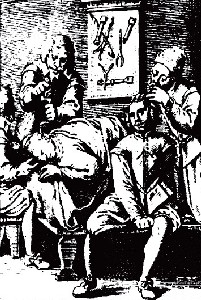
Trepanning, from The Workes of That
Famous
Chirurgeon Ambroise Parey
by Ambroise
Paré, Frontispiece (1649)
The patient continued to remain in the same state, so Atkins trepanned the wound despite finding no reason to do so. Then he dressed the wound with "a Sindon [medicated linen rag put into a trepanned hole] out of Sp. Vini. [rectified spirit distilled from wine] and Mell. Rosar. [honey and rose water] a little Ball of the same to fill the Perforation; and all the rest of our Dressings Dossils of dry Lint, excepting only a large Pledgit spread with Liniment, for the easier bringing them off, Compress, and Bandage."10
While that shows the use of the compress in this operation, the patient still was not recovering. Atkins had not really found the problem, as he explains. "About a Week after, the Patient having been often observed to lift his Hand toward the hinder Part of his Head, we found there, on Search, a Tumor with Matter collected in it, as appeared on opening; and what was more surprizing, a Fracture that gaped wide enough to pass a Probe through, and stretching a great Length on the Os Occipitis [occipatal bone located at the back of the head]"11
He trepanned again, this time at the back of the skull, but the patient eventually died. Atkins reveals why, explaining that upon "opening the Skull, the Fracture was found to be the whole Length of the Occipital Bone; and inside the Membranes abundance of fœtid Matter."12 Unfortunately for this lad, even the best surgeon can't win them all.
1 Richard Wiseman, Of Wounds, Severall Chirurgicall Treatises, p. 392; 1 Wiseman, p. 392; 3 John Moyle, Memoirs: Of many Extraordinary Cures, p. 1; 4 Moyle, p. 6; 5 Moyle, p. 18; 6,7 Moyle, p. 19; 8,9,10 John Atkins, The Navy Surgeon, p. 91; 11,12 Atkins, p. 92

